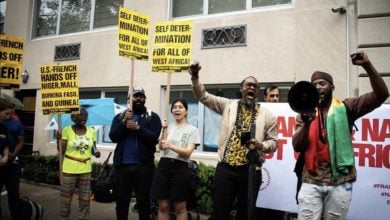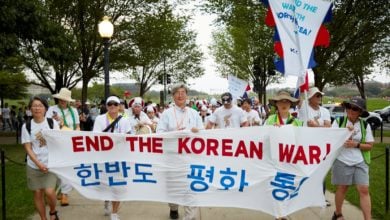North Korea has proclaimed proudly that it carried out its first nuclear weapons test. The government in Pyongyang has announced to the world that it is ready for “negotiations or confrontation.”
Clearly, the intention of North Korea is to spur a new round of bilateral negotiations with the U.S. government. It seeks
|
People in the United States would be left with the impression that North Korea is a huge threat to world peace now that it has carried out a nuclear test. Here is where actual facts come in handy.
U.S. military threat
The U.S. government has established the most substantial military empire the world has ever known.
The Department of Defense’s 2003 “Base Structure Report” shows that its worldwide physical assets consist of “more than 600,000 individual buildings and structures, at more than 6,000 locations [the exact number is given as 6,702], on more than 30 million acres.” Of these 6,702 military installations, about 1,000 are outside of continental U.S. borders.
Another Department of Defense document—”Active Duty Military Personnel Strengths by Regional Area and by Country”—says the U.S. has a military presence in 135 of the 192 “independent states” it considers countries. The figure, however, is a conservative one. It does not account for the U.S. military’s presence in U.S. colonies, called “territories,” and in the water.
The total number of U.S. troops deployed abroad as of Sept. 30, 2003 was 252,764. This number does not include troops in Iraq or in countries the United States considers “possessions.” The total U.S. military personnel as of 2003—on and outside of U.S. soil—was almost 1.5 million. That means over 25 percent of U.S. troops are deployed internationally.
U.S. military deployment is not limited just to installations and troops abroad. Nearly 500 U.S. nuclear bombs are housed in Europe.
That number pales in comparison to the 12,000 nuclear weapons and components the United States had in 27 different countries and territories several decades ago. It included more than 2,000 nuclear weapons in the Asia-Pacific region. The deployment of these weapons was kept secret. It was only revealed recently in response to a Freedom of Information Act request.
In contrast, North Korea has no military installations, troops or nuclear weapons outside its borders.
Pentagon spending up
The 2007 Pentagon budget, just approved on Sept. 27 and 28 by both houses of Congress, combined with earlier Pentagon appropriations, is an incredible $464 billion.
This number does not account for tens if not hundreds of billions of dollars in additional “emergency spending” that the Bush administration will ask for next year. Such “emergency” funds pay for the colonial occupations of Iraq and Afghanistan and other imperialist adventures.
Washington’s military spending dwarfs all other countries.
In 2005, the U.S. military budget accounted for 43 percent of the total military budgets of 35 countries, according to the Center for Arms Control and Non-Proliferation.
North Korea ranked a distant 25th in military spending. Its budget of $5.5 billion accounted for just one percent.
U.S. nuclear stockpile and ‘bunker busters’
The U.S. military currently has 6,000 deployed strategic nuclear weapons and about 10,000 deployed or reserve nuclear weapons.
For the past five years, the Bush administration has repeatedly used the events of Sept. 11, 2001 to justify planning for the use of nuclear weapons, in “non-nuclear situations” against non-nuclear nations. The plan was first proposed in the Nuclear Posture Review submitted to Congress at the end of 2001. It later became official policy in the 2002 National Security Presidential Directive, known as the National Security Doctrine.
The 2006 federal budget included tens of millions to bolster the U.S. government’s nuclear stash: $7.7 million went to modern pit manufacturing facilities to produce new nuclear weapons, $25 million went to test site readiness, $9.4 million went to reliable replacement warheads, and $8.5 million went to robust nuclear earth penetrators, known as nuclear “bunker busters.” These new “bunker buster” nukes are specifically aimed at targets in North Korea and Iran.
Since 2001, there has been significant advancement in the development of nuclear “bunker busters,” a type of low-yield mini-nuclear weapon.
In October 2002, a committee of the Executive Branch, the Nuclear Weapons Council, wrote that “it would also be desirable to assess the potential benefits that could be obtained from a return to nuclear testing.”
In 2003, in response to a call by Bush, Congress repealed a 1994 ban on researching low-yield nuclear weapons.
Research on building a nuclear bunker buster was launched in 2004 by the National Nuclear Security Administration in the U.S. Department of Energy. That same year, the Bush administration submitted a budget of almost $500 million dollars for the development of these weapons over a five year period.
A major test that will help develop the “bunker buster” nukes is now being planned. “Divine Strake” was set for June 2006, but has been delayed. It likely would be the biggest controlled conventional explosion in military history, though much less powerful than the smallest weapon now in the U.S. nuclear stockpile.
Subverting reality to justify war
The notion that North Korea is the military threat and aggressor is false. It is nothing more than an “Alice in Wonderland” version of reality.
The U.S. military machine that spends trillions in its attempts to dominate the world’s people is the real threat to North Korea and all people who seek peace.
It is the duty of U.S. workers to stand with the Korean people against U.S. government war threats. Supporting North Korea’s struggle for self-determination, national liberation and reunification of the Korean peninsula is essential to building a world free of imperialist exploitation and war.
Click here to read more from PSL about North Korea’s nuclear test.







